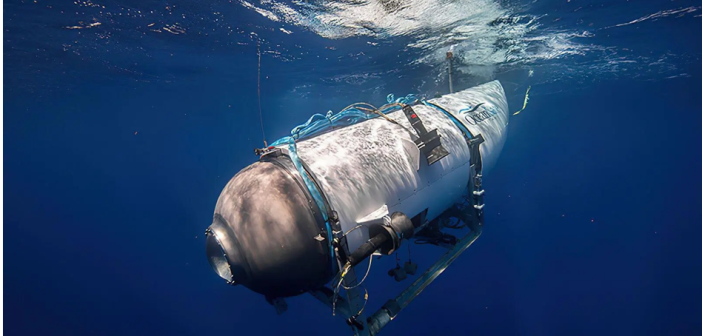At 10 a.m. on Sunday, June 18, the Canadian expedition ship Polar Prince launched its carbon-fiber and titanium 22-foot submersible, Titan, with five people on board, just over the wreck of the Titanic some 12,500 feet under the surface.
Just 1 hour and 47 minutes later, the Polar Prince lost all communication with the sub. It had not been seen or heard from ever since. There was enough oxygen on board to last about 96 hours; the air would run out on Thursday morning.
On Thursday afternoon, the Coast Guard said that a debris field, the result of a “catastrophic implosion” on the Titan, was found on the sea floor 1,600 feet from the bow of the Titanic. A deep-sea robot found five pieces of debris, including the Titan’s tail cone, in two separate fields on a smooth part of the ocean floor. In a press conference in Boston, Coast Guard officials offered their condolences to the families of the five men on board.
An international search and rescue effort involving planes and vessels from the U.S., Canada and others had been searching the area, roughly 400 miles south of St. John’s, Newfoundland, and 900 miles east of Cape Cod.
The search area reached twice the size of the state of Connecticut, in the hope that the sub somehow managed to reach the surface – somewhere. Even if that happened, there was no way for the crew to get out, since the hatches cannot be opened from the inside. As the search widened, the Coast Guard confirmed that sonar had picked up some sounds that could possibly have come from the Titan, but a spokesman said, “We don’t know what they are.”
The problem is that the Titanic lies far deeper than any regular submarine can dive.
OceanGate Expeditions, the Washington-based company that runs the Titanic dives, says that the Titan is the only crewed submersible in the world that can go that deep. The water pressure at that depth is hundreds of times higher than it is just below the surface.
Stockton Rush, an aerospace engineer who founded OceanGate in 2009, was serving as the pilot on this dive. The rest of the crew: Hamish Harding, 58, a British explorer who previously set a Guinness world record for deep ocean diving; Paul-Henri Nargeolet, 77, a French maritime expert who has already made 35 dives to the Titanic; and Shahzada Dawood, 48, a British businessman and his son, Suleman, 19.
OceanGate has taken people on dives to the Titanic site since 2021, charging $250,000 per person. The Titan weighs 23,000 pounds, and it can travel at 3 knots underwater, powered by four electric thrusters.
The New York Times reports that diving industry leaders warned OceanGate in a 2018 letter that the Titan could face “catastrophic” problems because of its “experimental” approach and its failure to follow established safety guidelines.
At the same time, the paper says, David Lochridge, the company’s director of marine operations, wrote a report saying the sub needed more testing and warned of “the potential danger to passengers of the Titan as the submersible reached extreme depths.” He said the viewport that lets passengers see outside the sub was certified to work at depths less than half the distance down to the Titanic. OceanGate ultimately fired him.
Rear Admiral John Maugeri, a spokesman for the U.S. Coast Guard, said at a press conference early in the week that “we are doing everything we can.” But, he added, it is “a challenge to conduct a search in that remote area.”
The Titanic, the largest ship in the world at the time, sank on its maiden voyage from Southampton, England, to New York, on April 14, 1912, after it hit an iceberg. Some 1,500 people died in the tragedy.
Read more at https://www.bbc.com/news/world-us-canada-65991651 and see the video below:




